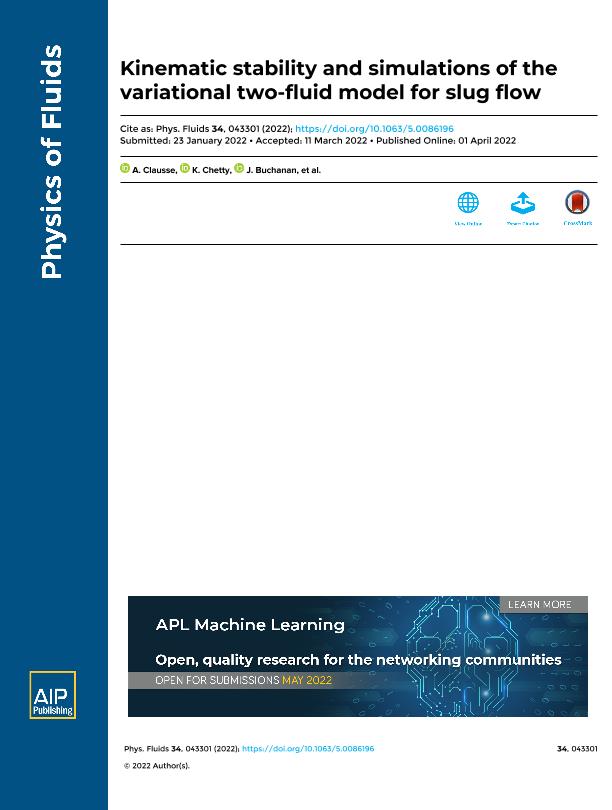Mostrar el registro sencillo del ítem
dc.contributor.author
Clausse, Alejandro

dc.contributor.author
Chetty, K.
dc.contributor.author
Buchanan, J.
dc.contributor.author
Ram, R.
dc.contributor.author
Lopez de Bertodano, M.
dc.date.available
2023-04-13T19:22:11Z
dc.date.issued
2022-04
dc.identifier.citation
Clausse, Alejandro; Chetty, K.; Buchanan, J.; Ram, R.; Lopez de Bertodano, M.; Kinematic stability and simulations of the variational two-fluid model for slug flow; American Institute of Physics; Physics of Fluids; 34; 4; 4-2022; 1-11
dc.identifier.issn
1070-6631
dc.identifier.uri
http://hdl.handle.net/11336/193772
dc.description.abstract
The two-fluid short-wave theory (TF-SWT) mode of the one-dimensional two-fluid model (TFM) [A. Clausse and M. Lopez de Bertodano, "Natural modes of the two-fluid model of two-phase flow,"Phys. Fluids 33, 033324 (2021)] showed that the incompressible kinematic and Kelvin-Helmholtz instabilities are the source of the long-standing ill-posed question. Here, the stability of the short wave mode is analyzed to obtain an unstable incompressible well-posed TFM for vertical slug flow, where inertial coupling and drag play the key role. Then, a computational method is implemented to perform non-linear simulations of slug waves. Linear stability analyses, i.e., characteristics and dispersion, of a variational TF-SWT for vertical slug flows are presented. The current TFM is constituted with a lumped-parameter model of inertial coupling between the Taylor bubble and the liquid. A characteristic analysis shows that this conservative model is parabolic, and it provides a base upon which other models can be constructed, including short-wave damping mechanisms, like vortex dynamics. The dispersion analysis shows that depending on the interfacial drag, the problem can be kinematic unstable. A new kinematic condition in terms of the inertial coupling and the interfacial drag is derived that is consistent with previous theoretical and experimental results. The material waves, which are predicted by linear stability theory, then develop into nonlinear slug waveforms that are captured by the numerical simulations. These and the horizontal stratified flow waves of previous research illustrate the TFM capability to model interfacial structures that behave like waves. Otherwise, when the physics of the TF-SWT waves is ignored, the model is ill-posed.
dc.format
application/pdf
dc.language.iso
eng
dc.publisher
American Institute of Physics

dc.rights
info:eu-repo/semantics/openAccess
dc.rights.uri
https://creativecommons.org/licenses/by-nc-sa/2.5/ar/
dc.subject
Two-fluid model
dc.subject
Slug flow
dc.subject
Stability
dc.subject
Two-phase flow
dc.subject.classification
Ingeniería Nuclear

dc.subject.classification
Ingeniería Mecánica

dc.subject.classification
INGENIERÍAS Y TECNOLOGÍAS

dc.title
Kinematic stability and simulations of the variational two-fluid model for slug flow
dc.type
info:eu-repo/semantics/article
dc.type
info:ar-repo/semantics/artículo
dc.type
info:eu-repo/semantics/publishedVersion
dc.date.updated
2023-04-13T18:18:45Z
dc.journal.volume
34
dc.journal.number
4
dc.journal.pagination
1-11
dc.journal.pais
Estados Unidos

dc.journal.ciudad
New York
dc.description.fil
Fil: Clausse, Alejandro. Comisión Nacional de Energía Atómica; Argentina. Consejo Nacional de Investigaciones Científicas y Técnicas. Centro Científico Tecnológico Conicet - Tandil; Argentina. Pontificia Universidad Católica Argentina "Santa María de los Buenos Aires"; Argentina
dc.description.fil
Fil: Chetty, K.. Purdue University. School Of Nuclear Engineering; Estados Unidos
dc.description.fil
Fil: Buchanan, J.. Naval Nuclear Laboratory; Estados Unidos
dc.description.fil
Fil: Ram, R.. Purdue University. School Of Nuclear Engineering; Estados Unidos
dc.description.fil
Fil: Lopez de Bertodano, M.. Purdue University. School Of Nuclear Engineering; Estados Unidos
dc.journal.title
Physics of Fluids

dc.relation.alternativeid
info:eu-repo/semantics/altIdentifier/url/https://aip.scitation.org/doi/10.1063/5.0086196
dc.relation.alternativeid
info:eu-repo/semantics/altIdentifier/doi/http://dx.doi.org/10.1063/5.0086196
Archivos asociados
